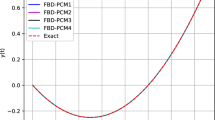Abstract
The momentous objective of this paper is to using a method with a free parameter which named optimum asymptotic homotopic method for finding solution of system differential equations featuring fractional derivative. To better understand the methodology and view its advantages compared to similar examples are presented.



Similar content being viewed by others
References
Magin, R.L., Abdullah, O., Baleanu, D., Zhou, X.J.: Anomalous diffusion expressed through fractional order differential operators in the Bloch–Torrey equation. J. Magn. Reson. 190(2), 255–270 (2008)
Scalas, E.: The application of continuous-time random walks in finance and economics. Physica A 362(2), 225–239 (2006)
Deshpande, A.S., Daftardar-Gejji, V., Sukale, Y.V.: On Hopf bifurcation in fractional dynamical systems. Chaos Solitons Fractals 98, 189–198 (2017)
Neamaty, A., Nategh, M., Agheli, B.: Local non-integer order dynamic problems on time scales revisited. Int. J. Dyn. Control 1–13 (2017)
Raja, M.A.Z., Samar, R., Alaidarous, E.S., Shivanian, E.: Bio-inspired computing platform for reliable solution of Bratu-type equations arising in the modeling of electrically conducting solids. Appl. Math. Model. 40(11), 5964–5977 (2016)
Guner, O., Bekir, A.: The Exp-function method for solving nonlinear space–time fractional differential equations in mathematical physics. J. Assoc. Arab Univ. Basic. Appl. Sci. 24, 277–282 (2017)
Sohail, A., Arshad, S., Ehsan, Z.: Numerical analysis of plasma KdV equation: time-fractional approach. Int. J. Appl. Comput. Math. 3, 1325 (2017)
Neamaty, A., Nategh, M., Agheli, B.: Time-space fractional Burger’s equation on time scales. J. Comput. Nonlinear Dyn. 12(3), 031022 (2017)
Ming, C., Liu, F., Zheng, L., Turner, I., Anh, V.: Analytical solutions of multi-term time fractional differential equations and application to unsteady flows of generalized viscoelastic fluid. Comput. Math. Appl. 72(9), 2084–2097 (2016)
Khandelwal, K., Mathur, V.: Exact solutions for an unsteady flow of viscoelastic fluid in cylindrical domains using the fractional Maxwell model. Int. J. Appl. Comput. Math. 1(1), 143–156 (2015)
Machado, J.T., Baleanu, D., Luo, A.C.J. (eds.): Discontinuity and Complexity in Nonlinear Physical Systems. Springer, Cham (2014)
Kilbas, A.A., Srivastava, H.M., Trujillo, J.J.: Theory and Application of Fractional Differential Equations. Elsevier B.V, Netherlands (2006)
Baker, G.: Differential Equations as Models in Science and Engineering. World Scientific Publishing Co Inc., Singapore (2016)
Salsa, S.: Partial Differential Equations in Action: From Modelling to Theory, vol. 99. Springer, Berlin (2016)
Agheli, B., Darzi, R.: Analysis of solution for system of nonlinear fractional Burger differential equations based on multiple fractional power series. Alex. Eng. J. 56(2), 271–276 (2017)
Duan, J., An, J., Xu, M.: Solution of system of fractional differential equations by Adomian decomposition method. Appl. Math. A J. Chin. Univ. 22(1), 7–12 (2007)
Momani, S., Odibat, Z.: Numerical approach to differential equations of fractional order. J. Comput. Appl. Math. 207(1), 96–110 (2007)
Patel, T., Meher, R.: Adomian decomposition Sumudu transform method for convective fin with temperature-dependent internal heat generation and thermal conductivity of fractional order energy balance equation. Int. J. Appl. Comput. Math. 3(3), 1879–1895 (2017)
Abdulaziz, O., Hashim, I., Momani, S.: Solving systems of fractional differential equations by homotopic-perturbation method. Phys. Lett. A 372(4), 451–459 (2008)
Zurigat, M., Momani, S., Alawneh, A.: Analytical approximate solutions of systems of fractional algebraic–differential equations by homotopic analysis method. Comput. Math. Appl. 59, 1227–1235 (2010)
Kumar, P., Agrawal, O.P.: An approximate method for numerical solution of fractional differential equations. Sign. Proc. 86, 2602–2610 (2006)
Yuste, S.B.: Weighted average finite difference methods for fractional diffusion equations. J. Comput. Phys. 216, 264–274 (2006)
Marinca, V., Herişanu, N., Nemeş, I.: Optimal homotopy asymptotic method with application to thin film flow. Open Phys. 6(3), 648–653 (2008)
Marinca, V., Herişanu, N., Bota, C., Marinca, B.: An optimal homotopy asymptotic method applied to the steady flow of a fourth-grade fluid past a porous plate. Appl. Math. Lett. 22(2), 245–251 (2009)
Marinca, V., Herişanu, N.: Application of optimal homotopy asymptotic method for solving nonlinear equations arising in heat transfer. Int. Commun. Heat Mass Transf. 35(6), 710–715 (2008)
Ali, L., Islam, S., Gul, T., Khan, I., Dennis, L.C.C.: New version of optimal homotopy asymptotic method for the solution of nonlinear boundary value problems in finite and infinite intervals. Alex. Eng. J. 55(3), 2811–2819 (2016)
Herisanu, N., Marinca, V.: Explicit analytical approximation to large-amplitude non-linear oscillations of a uniform cantilever beam carrying an intermediate lumped mass and rotary inertia. Meccanica 45(6), 847–855 (2010)
Author information
Authors and Affiliations
Corresponding author
Appendix: Illustration of Test Example 1 with Details
Appendix: Illustration of Test Example 1 with Details
Consider test example 1:
With considering
and
and using of O.HAM, for the first equation of (29) we can gain:
Equating the coefficients of different power in “p”, we have the following system of partial differential equations
Using of O.HAM, for the second equation of (29) we can gain:
Equating the coefficients of different power in “p”, we have the following system of partial differential equations
Rights and permissions
About this article
Cite this article
Darzi, R., Agheli, B. An Efficient Approach of Homotopic Asymptotic for System Differential Equations of Non Integer Order. Int. J. Appl. Comput. Math 4, 20 (2018). https://doi.org/10.1007/s40819-017-0463-9
Published:
DOI: https://doi.org/10.1007/s40819-017-0463-9



